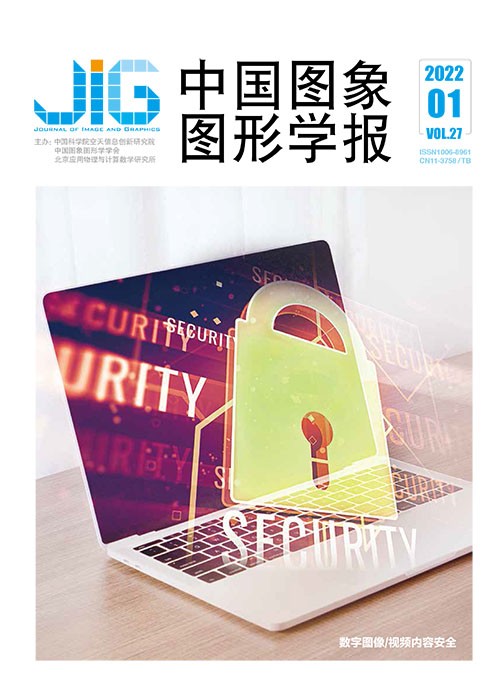
明文图像可逆信息隐藏综述
摘 要
图像可逆信息隐藏作为信息隐藏的重要分支,发展至今已近三十年,因其独有的图像无损恢复能力,一直备受医学、司法、军事等重点领域的青睐。然而现有可逆信息隐藏研究成果繁多,迁移知识广泛,本文简要梳理可逆信息隐藏的发展脉络,在回顾经典算法的基础上,加以简化、注释,总结成功经验,展望潜在应用,以期为研究者提供一个按图索骥的探索路径。本文主要包括3个部分,分别为位图(Bitmap,BMP)图像的可逆信息隐藏(适用于空域嵌入操作)、JPEG (Joint Photographic Experts Group)图像的可逆信息隐藏(适用于频域和编码域嵌入操作)和鲁棒可逆水印(适用于扩展性研究)。通过近百篇高影响力文献的梳理可知,可逆研究的受众广泛、基础深厚,其严谨的数学定义和简明的机理论证是深受研究者推崇和坚持的重要原因。“干净、简明”的特点也是其能够与现实应用有效结合的强力抓手。增加可逆算法对于载体多样性的普适性研究,引入新的评价指标来导引算法与现实应用的融合,将是未来可开拓的方向。可逆信息隐藏技术能够恢复图像初始状态,其独特之处在于图像本身就是一个复杂语义的信息表达。这既要求可逆嵌入操作所施加的影响不能改变图像所表达的主要语义,又要求该操作是可消除的,保留溯源能力,将内容的信息表达权始终交由图像本身。这一特点不仅为敏感领域信息处理所亟需,也是其他常见领域并不排斥的。严格来说,一定程度上的复原本就是事物发展到一定阶段后的必然追求。据此,本文认为推广可逆研究与多学科融合解决更难、更广泛的问题,实现长远发展,是完全必要且可行的。
关键词
Overview of reversible data hiding in plaintext image
Ou Bo1, Yin Zhaoxia2, Xiang Shijun3(1.Hunan University, Changsha 410082, China;2.Anhui University, Hefei 230601, China;3.Jinan University, Guangzhou 510632, China) Abstract
As a branch of hidden information, reversible data hiding (RDH) has been developed over three decades. The key character of RDH differentiation is the reversibility that can ensure the adequate recovery of both the original image and the hidden message. The applications of targeted occasions have been focused on, such as medical, judicial and military image processing. Currently, RDH community has derived an enormous number of algorithms, each of which entangles a specialty of the other discipline. It may torture the consistent study of primary learners as they cannot control the situation and then feel confused and frustrating. The brief guidance may be required to provide a unique pathway of RDH research. The initial works have put more emphasis on the classical algorithms and aim to awake them simplistic and friendly. The potentials for the future are summarized and new scientific issues are proposed to integrate the RDH with the realistic applications, such as night image processing for surveillance and reconnaissance, image fusion for remote transmission storage, etc. In this review, we aim to provide a straightforward and explicit guideline for the readers with no formal training of this topic. We illustrate the typical RDH algorithms designed for the common images, and explain their motivations of reversible data embedding and extraction. Enlightened by the early-age motivations, we look forward the future directions to strengthen the close cooperation between RDH and the other leading disciplines. The whole paper consists of three parts, i.e., the researches for BMP images which are suited to the uncompressed images, the researches for JPEG images which are suitable for the coding-to-compression domain, and the robust reversible research in which more requirements are considered in the algorithm design to make RDH applicable for the practical case. In the reference list, nearly 100 papers are recommended for the study of this field. Most of the works are published in the top journals and conferences, and the significant influences of originality and innovation have been verified by the high citation rates in the past years. It is found that the RDH society has evolved into the form of great varieties and quantities. RDH is preferred by the expert and primary researchers due to its concise mathematical definition, simple experimental implementation and subtle embedding optimization. Such a simple and clear character allows RDH be easier to form a connection with the various applications without causing obvious conflicts. It is beneficial for the further development to have more discussions about the theoretical generality for diverse medium and introduce new evaluation metrics to guide the RDH design consisted with the practical application requirements. The unique feature of RDH is that it can recover the initial status of image when a change has taken place. It verifies that the image itself has the ability of recovery. In fact, the image is a sort of semantic expression relying on the strong but complicated data correlations. The correlations indicate that the image elements are similar to some extent, and can recover themselves in theory. In the existing works, the designers tend to understand the correlations at first, and then exploit the redundant elements to make space for hiding secret message. In a word, the algorithms revolve around the idea of better understanding the image. Of course, that how to interpret the correlations depends on the human-defined metric. In the current works, we are used to taking the PSNR metric to interpret the image, and then explore the boundary within which the distortion is acceptable and the main semantic information is preserved. However, merely PSNR is not sufficient to interpret the diversity of images. More metrics for different cases are better choices for the development of new and novel algorithms. Generally speaking, the reversibility is acceptable not only for the sensitive fields but also the common ones. The long-term development is feasible if RDH can respond more arising practical demands.
Keywords
reversible data hiding overview reversible embedding in spatial domain reversible embedding in frequency domain robust reversible embedding
|



 中国图象图形学报 │ 京ICP备05080539号-4 │ 本系统由
中国图象图形学报 │ 京ICP备05080539号-4 │ 本系统由